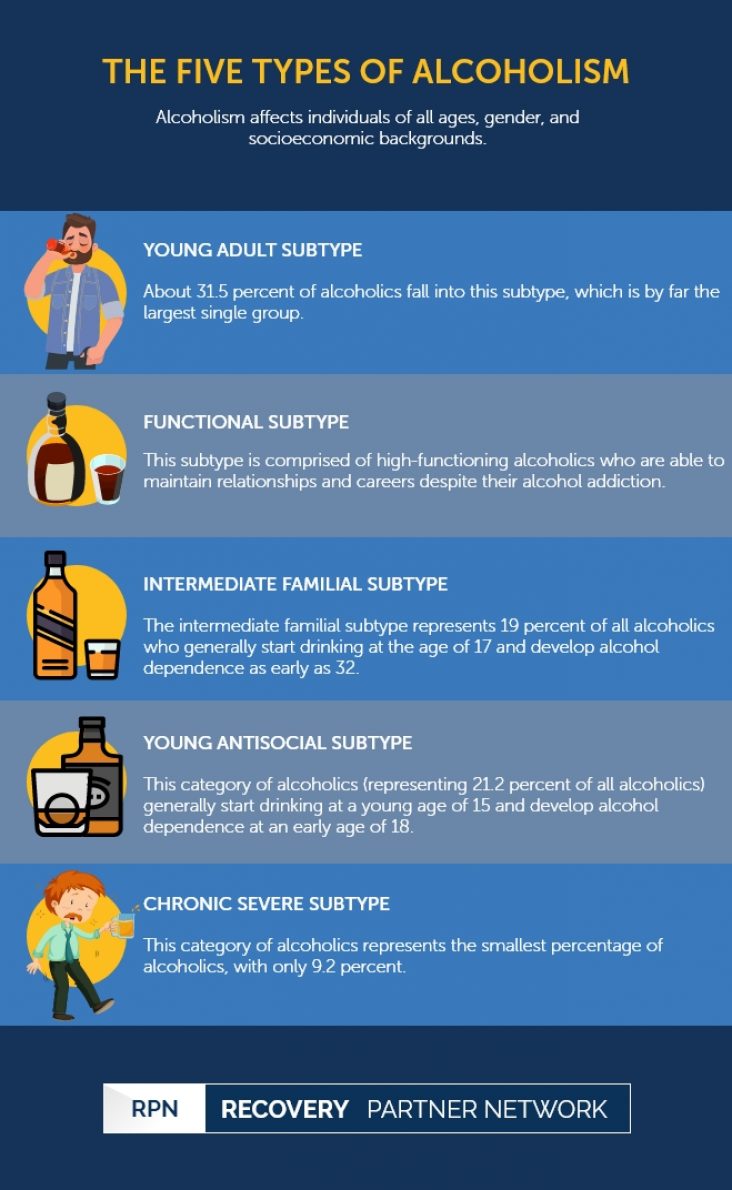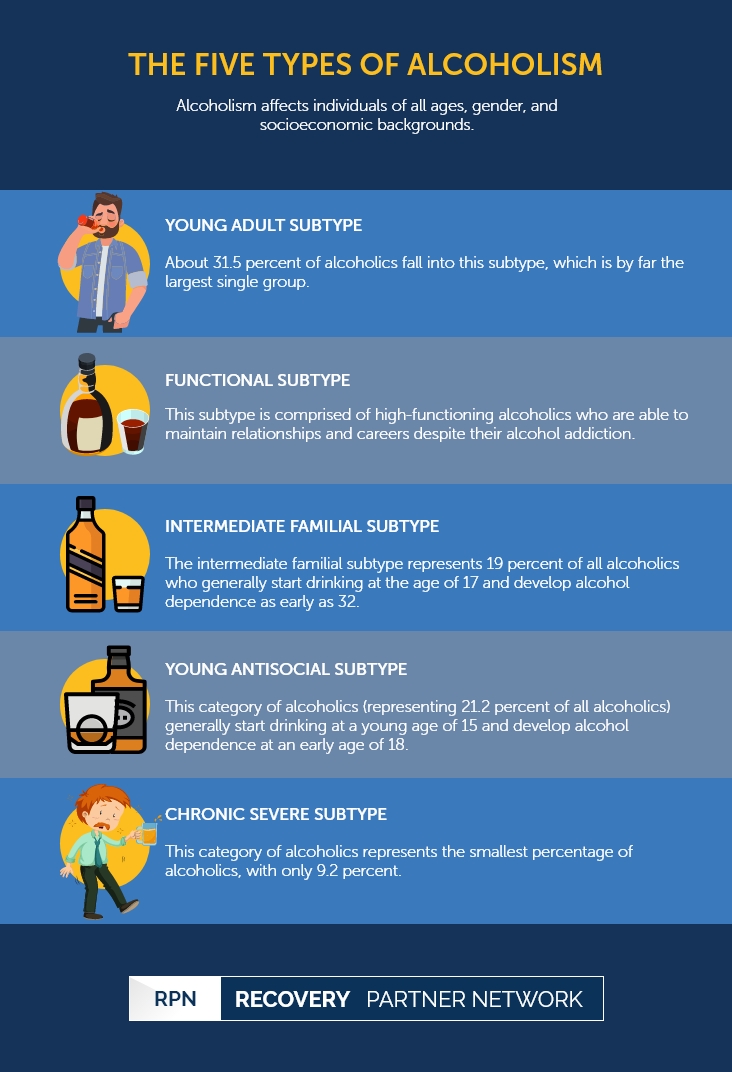Alcoholism affects individuals of all ages, gender, and socioeconomic backgrounds.
The Five Types of Alcoholism
The Five Types of Alcoholism | Table of Contents
The Five Types of Alcoholics
The National Institute on Alcohol Abuse and Alcoholism (NIAAA), National Institute of Health (NIH), and the National Epidemiological Survey on Alcohol and Related Conditions (NESARC) performed a national clinical study based on a number of research collected on alcoholics and discovered that alcoholics could be grouped under five main subtypes.
These subtypes include:
- Young adults
- Functional
- Intermediate familial
- Young antisocial
- Chronic severe
These subtypes are not a diagnostic means to determine if someone has an AUD: rather, they are viewed as a means to broaden the study on alcoholism and guide future research and preventive measures.
These subtypes were created based on factors such as:
- The age of the individual and the age they started drinking
- The age they developed alcohol dependence
- Their family history of alcoholism
- The presence or absence of any mental health conditions or substance use disorders
While different types of alcoholicsof reasons, some may even be oblivious to the f grapple with alcoholism for a variety act that they have a drinking problem.. Nevertheless, no matter the subtype, alcoholism causes long-term issues that can be detrimental to one’s health and relationships. According to the National Council on Alcoholism and Drug Dependence (NCADD),, alcohol is a contributing factor to around 40 percent of all violent crimes reported in the US.
FAQ
- What causes alcoholism?
- What is the most common drink for alcoholics?
- What are the signs and symptoms of chronic alcoholism?
Alcoholism is the result of a combination of factors such as genetics, environmental, social, and psychological. The more risk factors a person exhibits, the more likely for a person to abuse alcohol.
Beer is the most popular alcoholic beverage worldwide. In fact, after water and tea, beer is the most commonly consumed drink in the world. Beer is also considered to be the oldest alcoholic beverage in history.
Signs and symptoms of chronic alcoholism may include sweating, rapid heartbeat, hand tremors, problems sleeping, nausea and vomiting, hallucinations, restlessness and agitation, anxiety, and occasionally seizures.
Young Adult Subtype
Around 31.5 percent of alcoholics fall into this subtype, which is by far the largest single group. Alcoholics within this category generally start drinking at an early age of 19 and also form alcohol dependence as early as 24 years of age. These alcoholics show comparatively low rates of co-occurring mental health disorders and moderate levels of substance use disorders.
The young adult subtype is less likely to be employed or married but is more likely to be in college in comparison to other subtypes. Although this category consumes less frequently than others, they are more prone to engage in binge drinking. Individuals in this category are 2.5 times more likely to be male than female. They are less likely to pursue treatment, although there is a high possibility of them seeking out a 12-step program if they decide to do so.
As the brains of these young adults are in the process of developing, they retain a higher chance of developing an AUD through prolonged alcohol consumption. About one-third of AUD patients in the US started off as a part of the young adult subtype.
Functional Subtype
This subtype is comprised of high-functioning alcoholics who are able to maintain relationships and careers despite their alcohol addiction. This subtype represents 19.5 percent of all alcoholics, who are mostly middle-aged individuals. These individuals generally start drinking at the age of 18 and develop alcohol dependence later in life. This category generally suffers from moderate levels of depression, low rates of other co-occurring disorders, and very low rates of other substance use disorders. About 60 percent of this category is male.
These individuals are the most-educated and well-off out of all categories, and half of them are most likely to be married. Although these alcoholics appear to be functional, they still suffer from an addiction to alcohol. Less than 20 percent of this category seek help, and most do so through a 12-step program or private health care professional.
Intermediate Familial Subtype
The intermediate familial subtype represents 19 percent of all alcoholics. These individuals generally start drinking at the age of 17 and develop alcohol dependence as early as the age of 32. This category is highly likely to have antisocial personality disorders, depression, generalized anxiety disorders, bipolar disorders, and a family history of alcoholism. They also suffer from high rates of cigarette, cocaine, and marijuana addiction. Sixty-four percent of this category consists of males.
Although most individuals within this category are educated and employed, their income and level of education tend to be lower than that of functional alcoholics. These alcoholics generally do not seek treatment, but those who do tend to partake in self-help groups, specialty treatment programs, and detoxification programs.
Young Antisocial Subtype
About 21.1 percent of alcoholics fall into the young antisocial subtype. This category of alcoholics generally start drinking at a young age of 15 and develop alcohol dependence at an early age of 18. According to the National Institute on Drug Abuse, consuming alcohol before the age of 15 increases the chances of developing an AUD later in life. These individuals are six times more likely to suffer from AUD as an adult in comparison to other subtypes of alcoholics.
More than 50 percent of these individuals display traits of antisocial personality disorder and high rates of mental health disorders such as depression, social phobia, bipolar disorder, and obsessive-compulsive disorder. This category also shows the highest rates of other substance use disorders, including addiction to marijuana, meth, cocaine, opioids, and cigarette.
This subtype contains the lowest levels of employment, education, and income out of all other subtypes. This category is also likely to consume high levels of alcohol within a short period, although they drink less frequently than others. This category is more likely to seek treatment, with more than 35 percent of these individuals having pursued treatment for alcoholism. These alcoholics mostly seek treatment through private health care providers, self-help groups, detox programs, and specialty treatment programs.
Chronic Severe Subtype
This category of alcoholics represents the smallest percentage of alcoholics, with only 9.2 percent. Although this category of individuals generally starts drinking at the of 15, they usually develop alcohol dependence at an intermediate age of around 29 years old. Seventy-seven percent of this category has immediate family members with alcoholism, the highest percentage of any subtype, and 47 percent of this category exhibit antisocial personality disorder, the second-highest rate of any subtype. This subtype is the most likely out of all subtypes to undergo major depression, dysthymia, bipolar disorder, social phobia, panic disorder, and generalized anxiety disorder. This category also has addictions to cigarettes, marijuana, opioids, and cocaine.
More than 80 percent of this category experience acute withdrawal due to the persistent efforts to cut down, while more than 90 percent continue to drink despite it causing severe health or interpersonal issues. These alcoholics also tend to spend a considerable amount of time using and recovering from alcohol while also experiencing a reduction in productivity due to drinking. This category also reports the highest rate of emergency room visits due to drinking.
This category has the lowest rates of education and employment and the highest rates of divorce and separation. These alcoholics drink more frequently than the other subtypes, although their overall intake is lesser than the young antisocial subtype. Sixty-six percent of this category have sought assistance at some point, making them the highest by far to have done so. They often choose self-help groups, rehabilitation programs, and detox programs. They also have the highest rate of seeking treatment at an inpatient program or from private physicians, psychiatrists, and social workers
Recovery Partner Network
We aim to educate and empower. If you feel our library of resources does not cover your specific need, reach out to us, and we would be happy to help.
STATISTICS
© Copyright 2025


